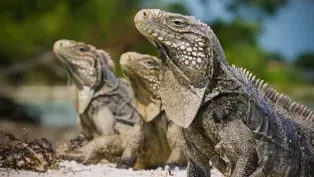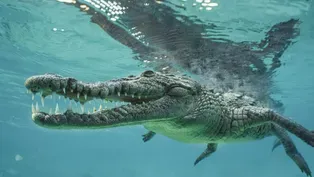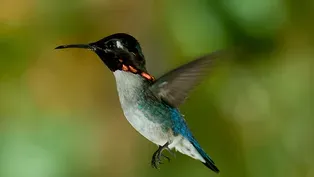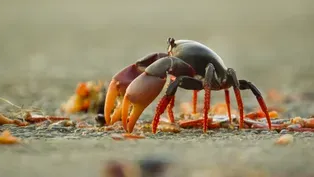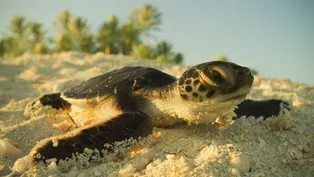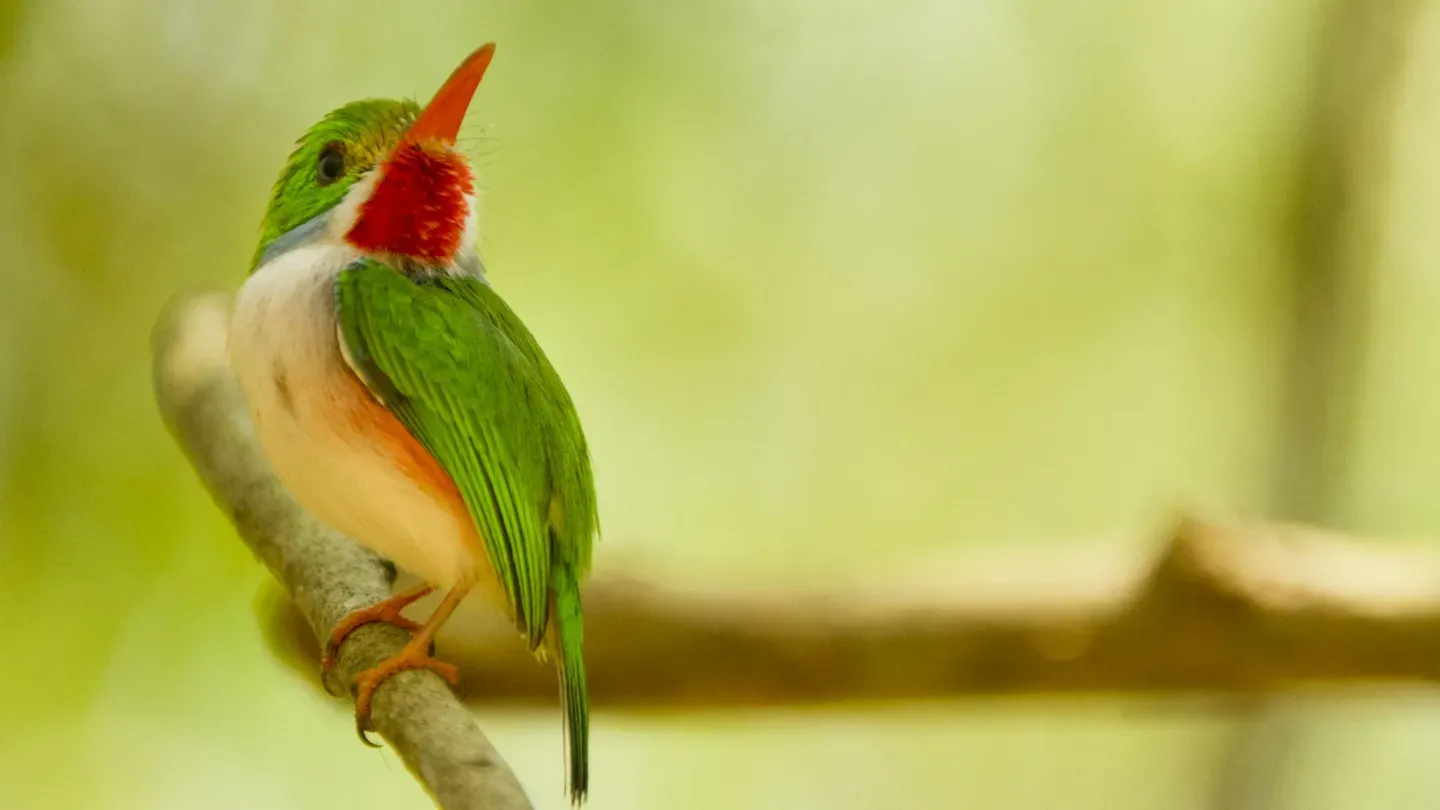

Cuba's Wild Revolution
Season 38 Episode 13 | 53m 13sVideo has Closed Captions
Get a glimpse of Cuba’s stunning animals and lands, left virtually untouched for 50 years.
In the crystal-clear waters of the Caribbean, Cuba is an island teeming with exotic biodiversity: from coral reefs pulsating with life to five-foot-long Cuban rock iguanas. As international relations ease, what will become of this wildlife sanctuary?
Problems with Closed Captions? Closed Captioning Feedback
Problems with Closed Captions? Closed Captioning Feedback
Major support for NATURE is provided by The Arnhold Family in memory of Henry and Clarisse Arnhold, The Fairweather Foundation, Sue and Edgar Wachenheim III, Charles Rosenblum, Kathy Chiao and...

Cuba's Wild Revolution
Season 38 Episode 13 | 53m 13sVideo has Closed Captions
In the crystal-clear waters of the Caribbean, Cuba is an island teeming with exotic biodiversity: from coral reefs pulsating with life to five-foot-long Cuban rock iguanas. As international relations ease, what will become of this wildlife sanctuary?
Problems with Closed Captions? Closed Captioning Feedback
How to Watch Nature
Nature is available to stream on pbs.org and the free PBS App, available on iPhone, Apple TV, Android TV, Android smartphones, Amazon Fire TV, Amazon Fire Tablet, Roku, Samsung Smart TV, and Vizio.
Buy Now

Explore More Ways to Watch
Bring the beauty and wonders of wildlife and natural history into your home with classic NATURE episodes.Providing Support for PBS.org
Learn Moreabout PBS online sponsorshipNARRATOR: Cuba, the greatest island in the Caribbean.
Today, Cuba has become the Caribbean's most precious natural jewel.
Its vast forests pulsate with life.
Crystalline waters hide breathtaking coral reefs.
While much of the wild lands and seas of the Caribbean are dying, Cuba's extraordinary history has made it a true wildlife wonderland.
Fully half of Cuba's animals and plants are found nowhere else on Earth... from unique crocodiles and snakes to the smallest birds and frogs on the planet.
There is nowhere quite like Cuba.
♪♪ ♪♪ ♪♪ ♪♪ ♪♪ NARRATOR: On the western edge of the Atlantic Ocean is a very special place -- an island from another time.
♪♪ Seeking out its wild and pristine shores... ...ancient creatures still come from the deep ocean.
A mother turtle, hoping the island will be as kind to her now as when she first left it more than 20 years ago.
In that time, she's roamed thousands of miles across the ocean until today, when a miracle of navigation has brought her back to the beach of her birth.
She has come home to Cuba.
A green turtle's journey home is one of the natural world's great miracles.
As her mother did before her, she has come home to lay her eggs.
[ Thunder crashing ] She is not built for land.
For her, nesting is a dangerous and exhausting affair.
♪♪ ♪♪ No ordinary patch of sand will do.
It must be damp and deep enough to protect her eggs... but far enough from high water to prevent the sea from flooding the nest.
♪♪ ♪♪ It's two hours of hard labor.
[ Thunder rumbling ] ♪♪ ♪♪ Then she enters a trance.
Almost nothing will stop her now.
Some 80 to 200 eggs are the fruit of her incredible journey home.
Her last act for her unborn babies is to gently cover the nest.
She will never see them again.
♪♪ Two months will pass before her precious eggs hatch, if the sands of her Cuban beach continue to protect them.
♪♪ [ Thunder rumbling ] Green turtles are just one of countless animals that depend on Cuba for wild space to live and breed.
In Cuba's southwest lies a vast region of wild swamp and forest... ...Zapata -- the largest single protected area in the entire Caribbean... ...2,300 square miles of biosphere reserve.
Zapata is home to creatures found nowhere else.
♪♪ One of the most remarkable is the very smallest bird on Earth -- the bee hummingbird.
Barely larger than the bee it's named after, almost everything about this hummingbird is special.
♪♪ They can beat their tiny wings an incredible 80 times a second.
Their tiny size makes them tasty prey for snakes, birds, even spiders.
Nothing about the bee hummingbird's life is easy.
They may visit over a thousand flowers a day on their eternal quest for nectar.
[ Birds chirping ] The males are the show-offs of the family -- their dazzling head feathers usually irresistible to the less-colorful females.
But this lady's showing no interest.
She has already mated.
For her, it's nesting time.
♪♪ What better material to make a tiny bird's nest than silk from a spider's web.
♪♪ ♪♪ ♪♪ ♪♪ In a final flourish, she tiles the outside with tiny scraps of lichen, both camouflage and water-proofing against any tropical rain.
The whole nest is smaller than a golf ball.
[ Birds chirping ] The mother will lay one or two eggs the size of coffee beans.
And then all she can do is wait.
Three weeks must pass before she'll know if all is going to plan.
[ Waves crashing ] The very first human beings only settled on Cuba some 5,000 years ago.
They came across the sea -- a voyage from the mainland of some 60 miles.
And their journey was rewarded with a vast paradise island.
♪♪ ♪♪ Observing from the shore, strange creatures witnessed their arrival... ...creatures that had been here for 3 million years before them.
♪♪ These are Cuban rock iguanas.
Still found on small sections of Cuba's mainland and outer islands, these iguanas can grow almost 5 feet long.
♪♪ With few predators about, stress seems an alien concept for the masters of this tropical shore.
♪♪ [ Insect buzzing ] But then breeding season arrives, and life gets a lot more interesting.
♪♪ The iguanas may have hardly moved a muscle for a week, but they can move fast when their masculinity is on the line.
♪♪ The dominant males win the ladies and mating is a less than elegant affair.
But the disruption is short-lived.
Peace and harmony soon return to this patch of paradise.
♪♪ ♪♪ In Zapata, three weeks have passed since the mother hummingbird laid her tiny eggs.
♪♪ It's a good year, and two healthy chicks have hatched.
Blind and helpless at birth, the chicks grow explosively, doubling their weight in just four days.
♪♪ Bee hummingbirds are so scarce and their tiny nests so hard to find that this is a scene rarely, if ever, filmed before.
♪♪ ♪♪ 18 days after hatching, the chicks have already grown their flight feathers.
In just a couple of days, they will leave the nest for good and, with luck, live up to seven years.
A whole new chapter in the story of the world's smallest bird.
[ Bird whistling ] [ Birds chirping ] The first humans who settled on Cuba were the Taino.
For 5,000 years, they lived by the shore and in these forests with little impact on the natural world that supplied all their needs.
But barely 50 years after Europeans arrived, the Taino had all but disappeared.
An entire culture wiped out in a storm of slavery and disease.
Today, few traces survive, but still with us is the name they gave their beautiful island -- Cuba, a faint echo of a lost people.
♪♪ ♪♪ Today nearly 12 million human beings live on Cuba, over 2 million in the capital of Havana.
Barely 90 miles from Florida, Havana could be on a different planet to its North American neighbor.
♪♪ Founded in 1519, Havana's old city feels like a time tunnel.
♪♪ Today's Cubans are a diverse mix of backgrounds and cultures -- European, African, Taino.
The slave trade had a huge impact.
1 million people torn from their West African homes and thrown across the island.
African influences are everywhere.
♪♪ ♪♪ The slave ships didn't only bring humans to Cuba.
Hiding aboard were stowaways who jumped ashore at every opportunity.
♪♪ [ Cheers and applause ] A long way from Ghana and Liberia, tropical house geckos stalk Havana's city streets.
♪♪ ♪♪ In recent times, the geckos have started to move out of the cities and across the Cuban countryside, yet another stage in a remarkable journey from their African forest homes.
♪♪ [ Air horn blowing ] Today a whole new fleet of vessels sails into Havana's legendary harbor... [ Air horn blowing ] ...cruise ships by the hundreds, and soon, passengers by the millions.
Desperate for foreign currency, Cuba's opening her doors to the outside world.
So mass tourism is one of the greatest challenges now facing Cuba and its natural world.
[ Thunder crashes ] It's now early April, and Cuba's wet season has begun.
Here near the Bay of Pigs on the south coast, an army is gathering.
♪♪ In one of nature's great migrations, red land crabs are on the move.
And many carry a precious cargo -- up to 80,000 eggs apiece that need water to survive -- salt water.
The mother's mission is to get to the sea.
That can be 4 1/2 miles away -- a journey fraught with danger.
♪♪ ♪♪ Millions of years of evolution has equipped the crabs to survive in the forests at night.
But roads and traffic are an entirely different matter.
Their journey becomes a dance with death.
♪♪ ♪♪ Even mortally wounded, deep instincts drive the crabs on.
♪♪ Despite their losses, most crabs make it through and press on with their journey to the sea.
♪♪ ♪♪ Now on the final stretch, they can smell the salt in the air.
♪♪ Though surrounded by ocean, these red crabs have evolved to live almost entirely on land.
But there is one deep link to their ancient past.
They must deliver their eggs to the sea.
♪♪ ♪♪ Once the mother feels salt water, she releases her eggs in what seems like a frenzy of joy.
♪♪ ♪♪ The mother's arrival here is timed to meet high tides and hopefully calm water, for they must be very careful.
Though born in these waters, they are land crabs now.
But many take a step too far.
While making sure to release their precious young, these mothers will never make it back to their forest home.
♪♪ ♪♪ ♪♪ The deep waters off Cuba are home to some of the greatest shark numbers in the Caribbean.
♪♪ An ancient perfect design, sharks have patrolled these seas little changed for more than 50 million years.
♪♪ And this is their last great refuge in the entire Caribbean.
Jardines de La Reina -- The Gardens of the Queen.
Lying off Cuba's southern coast, the Gardens are a marine wonderland.
More than 90 miles of islands, coral reefs, and mangrove swamps form one of the greatest barrier-reef systems on Earth.
♪♪ Travel beneath the surface here and you travel back in time, to when the Earth's seas were pristine.
♪♪ ♪♪ In the Gardens of the Queen, you find corals that survive almost nowhere else in the Caribbean -- rich stands of Elkhorn, one of the very first to die under the impact of humans.
♪♪ Coral reefs pulsate with life.
A single reef can hide 4,000 different kinds of plants and animals -- the richest single community of life on Earth.
♪♪ Sharks thrive on the rich marine life of the Gardens.
♪♪ The world's seas once teemed with these most successful of all ocean predators.
In the last 50 years, more than 90% have been killed by human beings.
♪♪ Today the Caribbean is in mortal danger, and it may lose all its living coral in less than 30 years.
The Gardens of the Queen is an orchestra of life in an ocean slowly falling silent.
[ Water falling ] So vital is Cuba to the wildlife of the region, it's been called the biological superpower of the Caribbean.
A fifth of the entire island is under some form of government protection.
The results are there to be seen -- ancient swamps and forests bursting with wildlife, unique wildlife.
Whatever way evolution has gone to work on Cuba, it has produced some very strange animals indeed.
Meet the Monte Iberia eleuth -- one of the smallest frogs in the world.
♪♪ It shares that distinction with cousins from Brazil to New Guinea.
But which one wins the title for tiniest of all is hard to decide as so few have been found.
Less than half an inch long when fully grown, it's not easy living in a world of giants.
♪♪ ♪♪ Unknown to science until just over 20 years ago, the eleuth is critically endangered and found in just two tiny areas of Cuba.
♪♪ These pint-size amphibians patrol the rainforest floor, forever on the lookout for danger.
♪♪ But she does have some survival tricks.
Her skin is poisonous and foul-tasting to most predators.
♪♪ And like so many others, from wasps to caterpillars, her black and yellow colors signal would-be predators to stay away.
This tiny snack carries a health warning!
[ Birds chirping ] ♪♪ Cuba's great forests once provided sanctuary for Fidel Castro and his revolutionaries.
Today they're a refuge for vast numbers of the island's native plants and animals.
♪♪ ♪♪ ♪♪ Some 26 different types of bats make their home in Cuba, seven found nowhere else on the planet.
♪♪ ♪♪ These are Cuban flower bats.
During the day, Cuban flower bats roost in deep caves.
At dusk, they head out in vast numbers to feed in the surrounding forests.
[ Bats squeaking ] Their cave home has only one exit, and this busy bat highway presents an opportunity.
♪♪ ♪♪ ♪♪ Cuban boas.
Up to a dozen snakes gather around this cave entrance.
♪♪ It is pitch black, though both do have some special sensory powers which they bring to this game of life.
The snakes have heat receptors which can detect an oncoming bat, while the bats' lives depend on their famous echolocation.
♪♪ Some snakes seem to coordinate their hunting positions, spacing themselves out to maximize their chances of a kill.
♪♪ ♪♪ ♪♪ Nervous and hungry, the bats make a dash for the exit and hope for the best.
But sooner or later, someone's luck runs out.
♪♪ ♪♪ Once caught, the bats know that this is the end.
Few put up any fight.
♪♪ ♪♪ The snakes finish off the bats with their powerful embrace, killing them in seconds.
♪♪ ♪♪ ♪♪ Fortunately for the bat colony, the snakes don't need much food to keep them happy.
One or two bats can satisfy this snake for a week or more.
Although harmless to humans, the boas are still hunted and harassed in Cuba.
Now officially endangered, their future is anything but assured... even on Cuba's green island.
[ Rooster crowing ] Cuba's particular history has been a major factor in helping preserve the island's natural world.
♪♪ After Fidel Castro seized power in 1959, conservation grew to become a government priority.
And at the same time, development has been limited.
Communist, and struggling under a U.S. embargo, Cuba's had few friends to help finance its industry and agriculture.
Today, most Cubans still live very simply, consuming a fraction of the resources used by an average American or European.
♪♪ All of this has meant less pressure on Cuba's wild animals and wild places.
[ Wind blowing ] [ Birds chirping ] ♪♪ Cuba is woodpecker heaven.
♪♪ Finding a good tree often means sharing with troublesome cousins.
Here two species are close neighbors -- a West Indian and a Cuban green woodpecker.
The green woodpecker nest has chicks inside, and their neighbor from upstairs is trouble.
♪♪ West Indian woodpeckers are known to kill other chicks and take over their nests.
♪♪ Luckily these chicks are now big enough to defend themselves.
The West Indian resigns herself to building her own nest.
The neighbors will just have to put up with the noise of construction... [ Woodpecker pecking ] ...and the debris.
♪♪ On the lower floor of the tree, the three green woodpecker chicks are getting close to the day they will leave home.
For the parents, it's still a non-stop battle to keep them fed and happy.
♪♪ ♪♪ ♪♪ Finally, the chicks are ready for the biggest step of their lives.
One needs a little persuasion.
♪♪ ♪♪ The parents will continue to feed the chicks until they're strong enough to fend for themselves.
♪♪ Cuba was born in a warm tropical sea.
Three quarters of the island is limestone, formed from the skeletons of sea creatures settling as fine sands on the seabed.
Millions of years of pressure and upheaval created the rock that forms most of the island today.
Limestone creates its very own wonderland.
As rain and water dissolves it over time, it riddles the island with caves, both above and below water.
♪♪ ♪♪ This is a cenote, a vertical cave of collapsed limestone.
Many are hundreds of feet deep.
♪♪ Over the eons, these peculiar places have become home to some very unusual creatures.
♪♪ And in Cuba, this is perhaps the most bizarre.
A primitive gar fish known as a manjuari.
♪♪ ♪♪ A true living fossil, manjuari have an extraordinary ability -- they can breathe air.
If their water becomes stagnant and oxygen runs low, they can gulp air from the surface to survive.
♪♪ Manjuari give a unique insight into how many millions of years ago, the very first fish evolved to leave the sea and survive on land -- a critical step in the evolution of life on Earth.
♪♪ ♪♪ Cuba has its very own species of crocodile found nowhere else, and they like to eat hutia, one of only two native land mammals found anywhere on the island.
♪♪ ♪♪ ♪♪ ♪♪ [ Birds chirping ] In the crocodile world, the Cubans are regarded as being especially intelligent and inquisitive.
[ Crocodile growls softly ] Beside their needle-sharp teeth, mobility is their other weapon.
Cuban crocodiles are extremely agile and can sprint at almost 10 miles an hour.
Come breeding season, the males go into action.
[ Crocodile growling ] Today, Cuba's unique crocodiles are in trouble.
Perhaps 3,000 survive in the wild.
As sea levels rise, larger American crocodiles are invading the freshwater swamps and interbreeding with the Cuban females threatening to wipe out the Cuban species.
♪♪ With so few of their kind left, every successful mating is a cause for celebration.
♪♪ ♪♪ They won't be independent for several months, but straight out of the egg, Cuban crocodile babies display the agility and resilience that has kept their kind alive for so many million years.
♪♪ Let's hope these survivors are a new beginning and not one of the final chapters in the story of the Cuban crocodile.
♪♪ [ Insects and birds chirping ] ♪♪ Cuba now stands at a crossroads.
For decades, the outside world has been kept largely at bay.
And for most Cubans, the pace of life has changed very little.
♪♪ But Cuba's systems are struggling.
There is now huge pressure for Cuba to develop -- more industry... more agriculture... more tourists.
Will her glorious wild lands and wild creatures pay the ultimate price?
♪♪ [ Waves crashing ] Under the sands of Cayo Largo, hundreds of new lives are stirring.
Their time has come.
♪♪ ♪♪ Two months have passed since the mother green turtle laid her eggs.
As the first babies break through, the eggs deep down hatch frantically so they're not left behind.
♪♪ Though this baby turtle has never opened her eyes before now, powerful instincts propel her towards the sound and smell of the sea.
♪♪ ♪♪ From the moment she left the warm embrace of the nest, she must fend entirely for herself.
For this new world is not a friendly one.
♪♪ ♪♪ On the very first journey of her life, there's a good chance she will not even make it to the water.
♪♪ ♪♪ This time, another hatchling has paid the price.
♪♪ Less than 1 in 1,000 baby turtles reach adulthood.
♪♪ ♪♪ Their best defense are other turtles.
That's why they hatch and break for the ocean together.
♪♪ ♪♪ ♪♪ She's made it to the sea, but there are countless challenges ahead.
In shallow water, she's easy prey and must get to deep water where she has some chance of surviving.
♪♪ ♪♪ If her luck holds, she will wander the open ocean, traveling thousands of miles over many years... until 20 years from now, a mysterious switch will make her turn and head back to Cuba to lay her own eggs.
The question is, will her home beach still be there and will Cuba welcome her with the same clean sands enjoyed by her ancestors for so many generations before her?
Only time will tell.
♪♪ ♪♪ ♪♪ ♪♪ ♪♪ To learn more about what you've seen on this "Nature" program, visit pbs.org.
♪♪
Cuba's Wild Revolution - Preview
Video has Closed Captions
Preview: S38 Ep13 | 35s | Get a glimpse of Cuba’s spectacular wildlife and landscapes. (35s)
Inside NATURE – Cuba's Wild Revolution
Video has Closed Captions
Clip: S38 Ep13 | 6m 1s | Cuba piqued the interest of filmmakers who hoped to capture the widely unknown island. (6m 1s)
Meet The Smallest Bird On Earth
Video has Closed Captions
Clip: S38 Ep13 | 2m 57s | The very smallest bird on Earth is the Bee Hummingbird, which can be found in the Zapata. (2m 57s)
Swarm of Crab Mothers Cross Traffic to Lay Thousands of Eggs
Video has Closed Captions
Clip: S38 Ep13 | 2m 48s | An army of Red land crabs migrates miles as mothers prepare to lay up to 80,000 eggs each. (2m 48s)
Watch Tiny Turtles Tumble Towards the Sea
Video has Closed Captions
Clip: S38 Ep13 | 2m 59s | Newborn turtles hurdle over obstacles as they tumble over the sand toward their new home. (2m 59s)
Providing Support for PBS.org
Learn Moreabout PBS online sponsorshipSupport for PBS provided by:
Major support for NATURE is provided by The Arnhold Family in memory of Henry and Clarisse Arnhold, The Fairweather Foundation, Sue and Edgar Wachenheim III, Charles Rosenblum, Kathy Chiao and...
